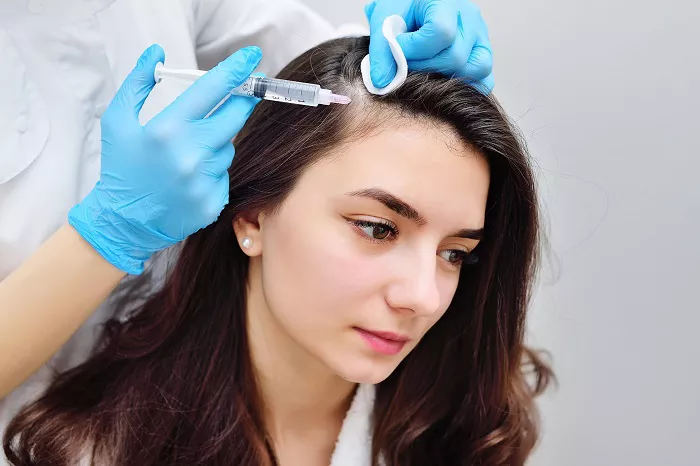Hair thinning and scalp issues have become increasingly common among young adults, with poor lifestyle choices often contributing to the problem. Factors such as lack of proper scalp care, unmanaged stress, smoking, poor sleep, and frequent chemical treatments can all play a role in early onset hair loss, according to Ms. Kim Fong, group chief trichologist at Svenson.
“Many young adults today are experiencing hair loss earlier, and much of it can be traced back to poor lifestyle choices,” Ms. Fong explains. “Lack of proper care can lead to early hair thinning or scalp issues, which may negatively affect self-confidence.”
While hair loss is often seen as a cosmetic concern or a part of the natural aging process, it can sometimes signal underlying health issues. Ms. Fong advises individuals who notice excessive hair loss – whether it’s more hair than usual in the brush or clogging the drain – to seek professional help.
Hair loss can manifest in various ways, from mild thinning and patchy bald spots to complete baldness. Its causes are multifaceted, ranging from lifestyle factors and hormonal changes to genetics and medical conditions.
For instance, telogen effluvium is a condition where stress, poor nutrition, illness, or hormonal fluctuations cause temporary hair shedding. Nutrient deficiencies – particularly in protein, iron, and vitamin A – can also impact hair appearance and scalp health.
Another common cause of hair loss is androgenetic alopecia, also known as male-pattern baldness. While this genetic condition affects both men and women, it is more prominent in men. Alopecia areata, an autoimmune disorder where the immune system attacks hair follicles, can also result in sudden bald patches. Emotional stress or physical trauma is often linked to the onset of this condition, although no specific trigger has been confirmed. If left untreated, alopecia areata can progress to alopecia totalis, causing complete hair loss.
Underlying all of these conditions is one crucial message: scalp health is vital. “Just as plants need healthy soil to grow, your scalp serves as the foundation for strong, healthy hair,” Ms. Fong explains. Even something as seemingly minor as dandruff can become problematic if scratching leads to follicle damage.
“Scalp and hair are closely connected – we need to care for both, not just one,” she adds.
Exosome Treatments: Advancing Scalp Health
As the field of scalp care advances, scientists are increasingly focusing on cellular interactions, which has led to growing interest in exosomes. These tiny particles, released by cells, play a key role in cell communication and may hold the key to enhancing scalp health, says Ms. Fong.
“Exosomes can interact with scalp cells,” she explains. “Research suggests they may help reduce inflammation, which is essential for overall scalp health.”
Svenson’s Micro-Exo treatment, launched in September 2024, leverages exosomes to address a range of scalp concerns, including aging and stress-related issues. The treatment, approved by the Health Sciences Authority, is suitable for individuals aged 21 and older who are experiencing hair concerns.
For those with an aging scalp, the treatment aims to improve blood flow and create a more supportive environment for hair growth. For individuals struggling with fine or weak-looking hair, the treatment delivers proteins that contribute to healthier scalp conditions. It also focuses on restoring balance for those experiencing scalp issues related to stress.
The Micro-Exo treatment is delivered through two methods:
Microneedling: This technique creates tiny channels in the scalp to facilitate deeper absorption of the exosomes. It also stimulates blood flow by triggering the skin’s natural healing response. Ms. Fong notes that while the treatment is generally comfortable on thicker skin, individuals with sensitive scalps may experience mild discomfort.
Needleless Technique: This FDA-approved, less invasive method uses electrical pulses to open microscopic channels in the scalp, enhancing absorption and circulation. It’s an ideal option for those who prefer a gentler approach to treatment.
Ms. Fong typically recommends a series of six to eight sessions, spaced one to two weeks apart. While microneedling may cause temporary redness or tenderness, patients can wash their hair after four hours, although waiting 24 hours is generally advised. It’s also recommended to avoid intense activities – such as swimming, gym workouts, saunas, or prolonged sun exposure – for at least three days after treatment.
The needleless approach comes with fewer restrictions, allowing most individuals to resume their usual activities, including washing their hair, after about four hours.
With advancements like exosome treatments, the future of scalp care looks promising, offering targeted solutions to improve both scalp and hair health.
Related topics:
- Men Share Their Hair Transplant Experiences, Highlighting Mixed Results
- DHI Chennai Cost: Comprehensive Guide
- DHI Hair Patch: Everything You Need to Know


